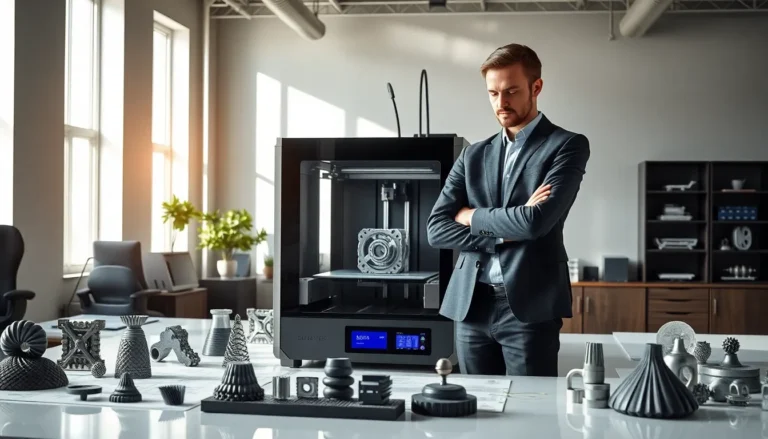Table of Contents
ToggleWhen diving into the vast sea of 3D printing, choosing the right software can feel like picking a favorite child at a family reunion, it’s that serious. Luckily, navigating this digital terrain doesn’t have to be daunting. Picture this: you’re all set to bring your imagination to life, armed with the perfect tools. Whether you’re a newbie or a seasoned designer, this guide will break down the software essentials, so you can spend less time stressing about compatibility and more time creating stunning 3D masterpieces. So, let’s put on our 3D glasses and explore the fantastic world of 3D printing software.
Understanding 3D Printing Software

3D printing software serves as the bridge between a designer’s vision and the physical object they produce. It involves a collaboration of multiple software types, each serving a crucial role in the printing process. Without this software, your creative ideas would remain trapped in the digital realm, never to see the light of day. Let’s break down the crucial parts to understand how these pieces fit together.
Types of 3D Printing Software
There are three major categories of software used in 3D printing, each catering to different stages of the printing process.
1. CAD Software
Computer-Aided Design (CAD) software lies at the heart of 3D modeling. It allows users to create detailed digital representations of their intended objects. Popular options like AutoCAD and SolidWorks provide robust features for intricate designs, while beginner-friendly alternatives like Tinkercad make it easy to jump in.
2. Slicing Software
With a design ready, slicing software takes over. Its job? Transforming the 3D model into a format that 3D printers can understand. This software slices your object into thin layers and generates the necessary G-code commands. Ultimaker Cura and PrusaSlicer are trusted players in this space, each offering unique features that streamline the slicing process.
3. Printing Software
Finally, once the model is sliced, it’s time for printing software to shine. This handles the communication between your 3D printer and the sliced file. Tools like OctoPrint provide advanced controls, allowing users to monitor and manage prints remotely.
Each type of software plays its part, ensuring the whole process runs smoothly from concept to creation.
Key Features to Look For
Choosing the right software isn’t just about personal preference: it’s about finding tools tailored to your specific needs. Here are key features that can make or break your 3D printing experience.
1. User Interface and Ease of Use
The software should be intuitive, especially for beginners. An easy-to-navigate interface can save countless hours of frustration. Look for clear tutorials and a layout that doesn’t resemble a complicated NASA control panel.
2. Compatibility with 3D Printers
Not all software works with all printers. It’s vital to ensure your chosen software supports the specific 3D printer model in use. Some software is optimized for particular brands or types of printers. Knowing this compatibility can streamline your entire workflow.
3. File Format Support
Different printers use different file formats. Whether it’s STL, OBJ, or others, ensure the software can export in the formats required by your printer. This will help prevent snafus in the printing process and ensure smooth sailing from design to delivery.
Popular Software Options
Exploring the software landscape is like browsing a candy store, you’ll find plenty of choices, each with its own unique flavors and capabilities. Here’s a look at some of the fan favorites among 3D printing enthusiasts.
1. Tinkercad
Perfect for beginners, Tinkercad offers an easy-to-use interface that allows users to create simple designs swiftly. With its drag-and-drop functionality, it’s a great entry point for those new to 3D modeling.
2. Fusion 360
For those looking to investigate deeper, Fusion 360 provides powerful CAD features. It’s more complex but incredibly versatile, making it perfect for professional applications.
3. Ultimaker Cura
Widely used as a slicing tool, Cura is open-source and free. It’s known for its simplicity and effectiveness, making it a top choice for both amateurs and pros.
4. PrusaSlicer
This software offers robust slicing capabilities, ideal for those using Prusa printers but versatile enough for others. Its user-friendly interface and strong community support are particularly appealing.
5. Blender
Blender isn’t just for animations: it’s a powerful tool for 3D modeling as well. While it has a steeper learning curve, its capabilities are virtually limitless, making it a go-to for professional designers.
Choosing the Right Software for Your Needs
With so many options available, how does one choose the right software? Consider these factors before making a decision.
Consider Your Skill Level
Start by assessing your experience. Newcomers might benefit from simpler software like Tinkercad, while experienced users may want to step up to Fusion 360 or Blender’s advanced features.
Define Your Project Requirements
Clarify what you aim to achieve. Are you making a simple toy, a prototype, or an intricate artistic piece? Your project’s complexity can guide your software choice.
Evaluate Community Support and Resources
Strong community support can make all the difference. Look for forums, user groups, and tutorials associated with the software you’re considering. A vibrant community can provide the help you need when you hit those inevitable bumps in the road.




